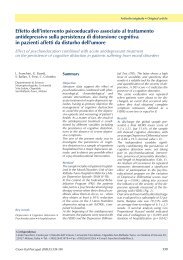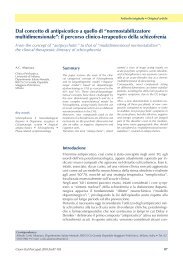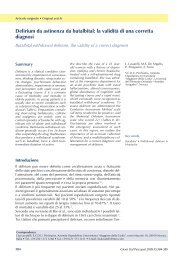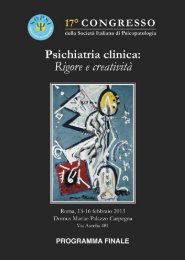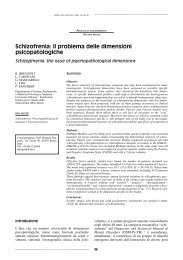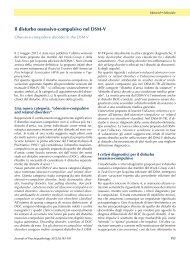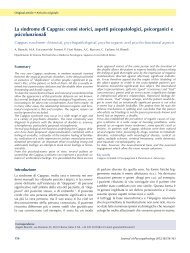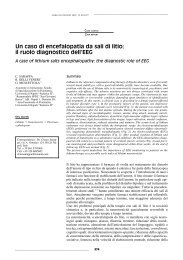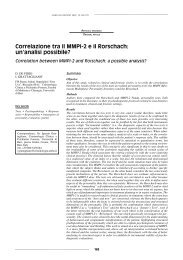XI Congresso della Società Italiana di Psicopatologia Psichiatria ...
XI Congresso della Società Italiana di Psicopatologia Psichiatria ...
XI Congresso della Società Italiana di Psicopatologia Psichiatria ...
You also want an ePaper? Increase the reach of your titles
YUMPU automatically turns print PDFs into web optimized ePapers that Google loves.
Obiettivo: valutare l’effectiveness <strong>di</strong> quetiapina in pazienti<br />
affetti da Disturbo Borderline <strong>di</strong> Personalità, monitorando<br />
sia le variazioni delle componenti comportamentali: aggressività,<br />
per<strong>di</strong>ta del controllo degli impulsi, sia le componenti<br />
psicopatologiche: instabilità emotiva e alterazioni ideative.<br />
Materiali e Meto<strong>di</strong>: sono stati stu<strong>di</strong>ati un totale <strong>di</strong> 25 pazienti<br />
con punteggio <strong>della</strong> Diagnostic Iterview for Borderline<br />
Patients (DIB ≥ 7). Il periodo <strong>di</strong> trattamento con quetiapina<br />
ad un dosaggio compreso tra 600-1.200 mg/<strong>di</strong>e è stato <strong>di</strong> 6<br />
mesi. Tempi <strong>di</strong> valutazione: T0, T1 (7° ± 2 gg), T2 (30° giorno),<br />
T3 (90° giorno), T4 (180° giorno). Sono state utilizzate<br />
scale atte ad esplorare l’area del comportamento, psicopatologica<br />
e del funzionamento sociale: BPRS, MADRS, Drug<br />
Attitude Inventory-10, Aggression Questionnaire, VGF.<br />
Risultati: si è rilevata una riduzione statisticamente significativa<br />
<strong>della</strong> BPRS, <strong>della</strong> MADRS, <strong>della</strong> DAI-10, dell’AQ e<br />
<strong>della</strong> VGF.<br />
Conclusioni: quetiapina ha <strong>di</strong>mostrato un’efficacia significativa<br />
nella gestione delle componenti comportamentali e <strong>di</strong><br />
quelle psicopatologiche.<br />
89. An Open-Label Trial Followed<br />
by a Double-Blind Discontinuation Phase<br />
of Escitalopram in the Treatment<br />
of Impulsive-Compulsive Internet Usage<br />
Disorder<br />
POSTER<br />
B. Dell’Osso * ** , A.C. Altamura ** , S.J. Hadley * , B.R. Baker<br />
* , E. Hollander *<br />
* Department of Psychiatry, Impulsive, Compulsive and<br />
Anxiety Disorders Program, Mount Sinai School of Me<strong>di</strong>cine,<br />
New York; ** Department of Psychiatry, University of<br />
Milan, Hospital “L. Sacco”, Milano<br />
Introduction: impulsive-Compulsive Internet Usage Disorder<br />
(IC-IUD) is characterized by excessive time spent on the<br />
internet at the expense of occupational, relationship and social<br />
activities. IC-IUD shares features of impulse control<br />
<strong>di</strong>sorders, OCD and substance abuse. This is the first study<br />
to examine the efficacy of escitalopram in the treatment of<br />
IC-IUD.<br />
Methods: nineteen subjects meeting study criteria for IC-<br />
IUD received open label escitalopram for 10 weeks and<br />
then were randomized to a 9-week double blind <strong>di</strong>scontinuation<br />
phase. The effect of escitalopram treatment on<br />
1) hours spent per week in non-essential internet use 2)<br />
obsessive, compulsive and total scores on IC-IUD-<br />
YBOCS and 3) Clinical Global Improvement scores was<br />
examined.<br />
Results: fifteen subjects completed both phases of the<br />
study. Escitalopram was well tolerated with minimal side effects.<br />
Significant improvement on the non-essential internet<br />
hours per week, IC-IUD-YBOCS and CGI (all p = 0,00) occurred<br />
during the first phase. The second phase from week<br />
10 to 19 found no significant <strong>di</strong>fference between placebo<br />
and escitalopram groups.<br />
Conclusions: escitalopram treatment resulted in significant<br />
improvement in IC-IUD. Behavioral changes in internet<br />
usage occurred in the first phase and were sustained<br />
during the second phase. Conceivably, escitalopram treatment<br />
improved subjects’ ability to decrease non-essential<br />
internet time allowing for more time spent in relationships,<br />
work and social activities. These behavioral changes could<br />
be reinforcing and explain continued improvement in IC-<br />
IUD. Future double-blind placebo controlled trials are<br />
needed.<br />
References<br />
1 Stein DJ. Internet ad<strong>di</strong>ction, Internet psychotherapy. Am J Psychiatry<br />
1997;154:890.<br />
2 Shapira NA, Lessig MC, Goldsmith TD, et al. Problematic internet<br />
use: proposed classification and <strong>di</strong>agnostic criteria. Depress<br />
Anxiety 2003;17:207-16.<br />
3 Stein DJ, Lessig MC, Goldsmith TD, et al. Problematic internet<br />
use: proposed classification and <strong>di</strong>agnostic criteria. Depress<br />
Anxiety 2003;17:207-16.<br />
90. Livelli <strong>di</strong> citochine e cortisolo ematici<br />
in pazienti affetti da Disturbo Post-<br />
Traumatico da Stress (PTSD) e Lutto<br />
Complicato<br />
L. Dell’Osso, C. Carmassi, A. Ciapparelli, S. Tonini,<br />
F. Mundo, G. Consoli, E. Da Pozzo, M.L. Trincavelli,<br />
M. Montali, M. Maccheroni * , A. Lucacchini, C. Martini<br />
Dipartimento <strong>di</strong> <strong>Psichiatria</strong>, Neurobiologia, Farmacologia<br />
e Biotecnologia, Università <strong>di</strong> Pisa; * Laboratorio <strong>di</strong> Endocrinologia,<br />
Azienda Ospedaliero-Universitaria Pisana, Pisa<br />
Il PTSD è caratteristicamente correlato all’esposizione ad<br />
eventi traumatici gravi; sempre più stu<strong>di</strong> riportano un’attivazione<br />
del sistema immunitario (SI) in pazienti (pz) sottoposti<br />
a eventi stressanti; in particolare nel PTSD sono<br />
state riscontrate concentrazioni sieriche elevate <strong>di</strong> IL1β e<br />
IL6, suggerendo un’alterazione funzionale nei sistemi che<br />
coinvolgono i glucocorticoi<strong>di</strong>.<br />
La <strong>di</strong>agnosi <strong>di</strong> CG è oggi ampiamente <strong>di</strong>battuta dai ricercatori,<br />
in particolare per la sua appartenenza nosografia al nucleo<br />
delle reazioni da stress; dati sulla presenza <strong>di</strong> alterazioni<br />
del SI e neuroendocrino (NE) sono tuttavia carenti.<br />
Al fine <strong>di</strong> esplorare le alterazioni del SI e NE in vittime <strong>di</strong><br />
eventi traumatici, sono stati valutati i livelli sierici <strong>di</strong> cortisolo<br />
e IL1β, IL6, TNFα in un campione <strong>di</strong> pz con PTSD<br />
e CG (Inventory of Complicated Grief Scale, ICG > 25) vs.<br />
controlli, reclutati presso la Clinica Psichiatrica 2 a dell’Università<br />
<strong>di</strong> Pisa. I pazienti sono stati indagati tramite la<br />
SCID, la ICG e l’Impact of Event Scale.<br />
Risultati preliminari mostrano, sia nei pz con PTSD che<br />
con CG, livelli <strong>di</strong> cortisolo tendenzialmente aumentati; solo<br />
l’IL1β risulta significativamente aumentata in entrambe<br />
i gruppi (p < 0,05) mentre un incremento, vicino alla significatività<br />
statistica, è stato evidenziato nel TNFα. L’insieme<br />
dei risultati suggeriscono un’alterazione del SI e NE<br />
in entrambi i <strong>di</strong>sturbi psichiatrici, confermando ulteriormente<br />
l’importanza dell’esplorazione <strong>di</strong> tali alterazioni<br />
biologiche in questi <strong>di</strong>sturbi.<br />
264




